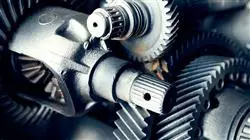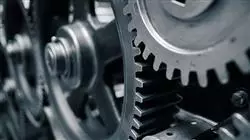University certificate
The world's largest faculty of engineering”
Introduction to the Program
Mechanical Engineering Design has been supported in recent years by new technologies, so professionals in this sector must have extensive digital skills"

TECH's Postgraduate diploma in Mechanical Engineering Design is a program designed specifically for professionals who need to strengthen their knowledge of both the conventional aspects of their professional activity and the most innovative aspects.
It has an international focus, with content based on that of the most prestigious universities in the world and is aligned with the recommendations of professional associations such as ASME (American Society of Mechanical Engineers) and IMechE (Institution of Mechanical Engineers).
The use of the case method facilitates the learning of concepts by avoiding systematic memorization and repetitive performance of complex calculations.
The content of thePostgraduate diploma combines the traditional, but necessary, aspects of the profession with the most innovative aspects, which are renewed in each edition.
With this prestigious training, students will learn to effectively face the challenges of the mechanical engineering profession by mastering all aspects of mechanics and gaining in-depth knowledge of innovation management and continuous improvement processes.
This Postgraduate diploma provides the necessary foundations to maintain an attitude of active observation of innovation, which allows professionals to remain updated and maintain a capacity to adapt to technological changes.
As it is an 100% online specialisation, the student is not bound by fixed schedules or the need to move to another physical location, rather, they can access the content at any time of the day, balancing their professional or personal life with their academic life.
The completion of this Postgraduate diploma will place Mechanical Engineering Design at the forefront of the latest developments in the sector"
This Postgraduate diploma in Mechanical Engineering Design is the most comprehensive and up-to-date educational program on the market. The most important features of the program include:
- The development of case studies presented by experts in Engineering Mechanisms
- The graphic, schematic, and eminently practical contents with which they are created provide scientific and practical information on the disciplines that are essential for professional practice
- Practical exercises where the self-assessment process can be carried out to improve learning
- Special emphasis on innovative methodologies in Engineering Mechanisms
- Theoretical lessons, questions to the expert, debate forums on controversial topics, and individual reflection assignments
- Content that is accessible from any fixed or portable device with an Internet connection
This Postgraduate diploma is the best investment you can make in selecting an updated program in the field of Engineering Mechanisms. We offer you quality and free access to content"
The teaching staff includes professionals from the engineering sector, who bring their experience to this training program, as well as renowned specialists from leading societies and prestigious universities.
The multimedia content, developed with the latest educational technology, will provide the professional with situated and contextual learning, i.e., a simulated environment that will provide immersive training programmed to train in real situations.
The design of this program focuses on Problem-Based Learning, by means of which the professional will have to try to solve the different situations of Professional Practice, which will be posed throughout the Postgraduate diploma. For this purpose, the professional will be assisted by an innovative interactive video system created by renowned and experienced engineering experts.
This training comes with the best didactic material, providing you with a contextual approach that will facilitate your learning"

This 100% online Postgraduate diploma will allow you to combine your studies with your professional work. You choose where and when to study"
Why study at TECH?
TECH is the world’s largest online university. With an impressive catalog of more than 14,000 university programs available in 11 languages, it is positioned as a leader in employability, with a 99% job placement rate. In addition, it relies on an enormous faculty of more than 6,000 professors of the highest international renown.

Study at the world's largest online university and guarantee your professional success. The future starts at TECH”
The world’s best online university according to FORBES
The prestigious Forbes magazine, specialized in business and finance, has highlighted TECH as “the world's best online university” This is what they have recently stated in an article in their digital edition in which they echo the success story of this institution, “thanks to the academic offer it provides, the selection of its teaching staff, and an innovative learning method aimed at educating the professionals of the future”
A revolutionary study method, a cutting-edge faculty and a practical focus: the key to TECH's success.
The most complete study plans on the university scene
TECH offers the most complete study plans on the university scene, with syllabuses that cover fundamental concepts and, at the same time, the main scientific advances in their specific scientific areas. In addition, these programs are continuously being updated to guarantee students the academic vanguard and the most in-demand professional skills. In this way, the university's qualifications provide its graduates with a significant advantage to propel their careers to success.
TECH offers the most comprehensive and intensive study plans on the current university scene.
A world-class teaching staff
TECH's teaching staff is made up of more than 6,000 professors with the highest international recognition. Professors, researchers and top executives of multinational companies, including Isaiah Covington, performance coach of the Boston Celtics; Magda Romanska, principal investigator at Harvard MetaLAB; Ignacio Wistumba, chairman of the department of translational molecular pathology at MD Anderson Cancer Center; and D.W. Pine, creative director of TIME magazine, among others.
Internationally renowned experts, specialized in different branches of Health, Technology, Communication and Business, form part of the TECH faculty.
A unique learning method
TECH is the first university to use Relearning in all its programs. It is the best online learning methodology, accredited with international teaching quality certifications, provided by prestigious educational agencies. In addition, this disruptive educational model is complemented with the “Case Method”, thereby setting up a unique online teaching strategy. Innovative teaching resources are also implemented, including detailed videos, infographics and interactive summaries.
TECH combines Relearning and the Case Method in all its university programs to guarantee excellent theoretical and practical learning, studying whenever and wherever you want.
The world's largest online university
TECH is the world’s largest online university. We are the largest educational institution, with the best and widest online educational catalog, one hundred percent online and covering the vast majority of areas of knowledge. We offer a large selection of our own degrees and accredited online undergraduate and postgraduate degrees. In total, more than 14,000 university degrees, in eleven different languages, make us the largest educational largest in the world.
TECH has the world's most extensive catalog of academic and official programs, available in more than 11 languages.
Google Premier Partner
The American technology giant has awarded TECH the Google Google Premier Partner badge. This award, which is only available to 3% of the world's companies, highlights the efficient, flexible and tailored experience that this university provides to students. The recognition as a Google Premier Partner not only accredits the maximum rigor, performance and investment in TECH's digital infrastructures, but also places this university as one of the world's leading technology companies.
Google has positioned TECH in the top 3% of the world's most important technology companies by awarding it its Google Premier Partner badge.
The official online university of the NBA
TECH is the official online university of the NBA. Thanks to our agreement with the biggest league in basketball, we offer our students exclusive university programs, as well as a wide variety of educational resources focused on the business of the league and other areas of the sports industry. Each program is made up of a uniquely designed syllabus and features exceptional guest hosts: professionals with a distinguished sports background who will offer their expertise on the most relevant topics.
TECH has been selected by the NBA, the world's top basketball league, as its official online university.
The top-rated university by its students
Students have positioned TECH as the world's top-rated university on the main review websites, with a highest rating of 4.9 out of 5, obtained from more than 1,000 reviews. These results consolidate TECH as the benchmark university institution at an international level, reflecting the excellence and positive impact of its educational model.” reflecting the excellence and positive impact of its educational model.”
TECH is the world’s top-rated university by its students.
Leaders in employability
TECH has managed to become the leading university in employability. 99% of its students obtain jobs in the academic field they have studied, within one year of completing any of the university's programs. A similar number achieve immediate career enhancement. All this thanks to a study methodology that bases its effectiveness on the acquisition of practical skills, which are absolutely necessary for professional development.
99% of TECH graduates find a job within a year of completing their studies.
Postgraduate Diploma in Mechanical Engineering Design
The design, manufacturing, maintenance, and repair of machines, equipment, facilities, or plants are of vital importance to the existence and sustainability of the industrial sector. To carry out this complex process, it is necessary to possess a set of knowledge in this field, encompassing everything from engineering techniques to the certifications and standards that regulate mechanical components. This program, offered by TECH Global University, includes specialized content that allows students to acquire these skills by addressing failure theories, tribology, and lubrication. Additionally, the thematic areas that make up the curriculum enable the development of skills in the design and evaluation of rigid and flexible transmissions, bearings, bushings, gears, clutches, couplings, springs, and both permanent and non-permanent joints. Moreover, this theoretical-practical journey covers the calculation of structures for all types of installations, as well as the manufacturing and assembly of polymers, ceramic materials, and composite parts through forming processes. Throughout the program, professionals will simultaneously focus on the safety and reliability conditions that the elements they design must meet.
Postgraduate Diploma in Mechanical Engineering Design
Through this graduate program at TECH, engineers will deepen their knowledge of mechanical devices, using an unmatched methodology that includes problem-based learning and relearning. This ensures their full integration into both academic and professional spheres, as they will be capable of developing systems, patents, and utility models that integrate industrial design, electronics, and mechanics. Furthermore, students will be able to analyze material behavior to create improvement and maintenance plans that ensure the durability of components, as well as the energy efficiency of their operation. All of this will be done by applying safety management programs, risk matrices, operational hazard studies, as well as principles of circular economy and environmental management. In this way, future experts will successfully propose and execute engineering projects, applying advanced and innovative methods that contribute to the development of Industry 4.0.







